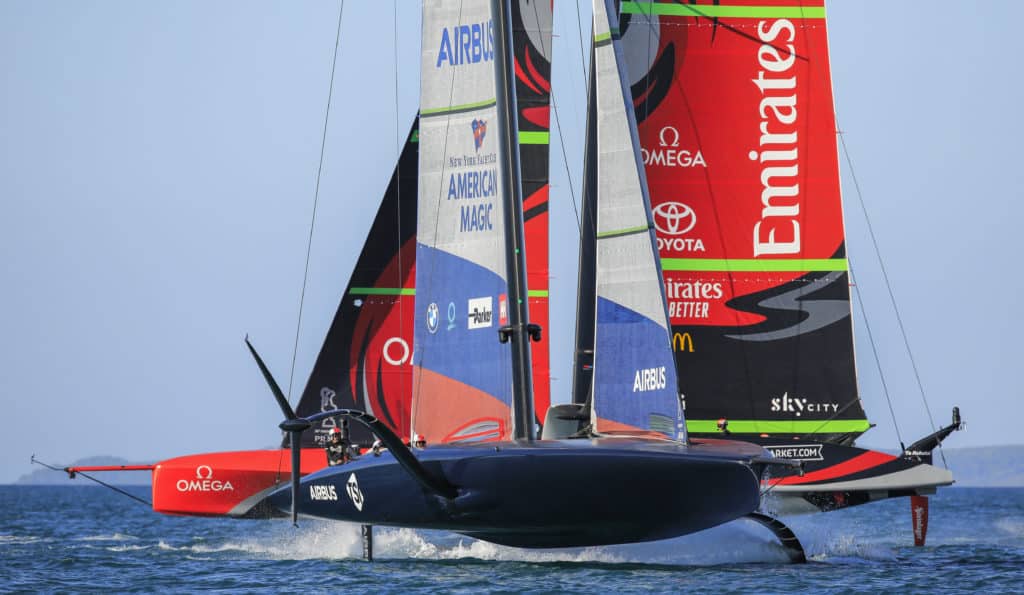
Practice Races – Day 3
America’s Cup racing, no matter the vehicle, the venue, or the shape of the racecourse, is still just a sailboat race. That much, at least, was the assessment of Luna Rossa Prada Pirelli Team’s Max Sirena when asked at the America’s Cup World Series Auckland opening press conference what he’d learned from informal scrimmages of the past few days: “It’s a yacht race…It’s a sailboat, you have to start well, you have to go to the right side. If you go fast to the wrong side…you want to try to avoid that.”
Fair enough.
And so it went—the opening remarks from the 36th regatta’s kick-off presser, hosted by America’s Cup Hall of Famer, Bruno Troublé, from Auckland. With Troublé at stage left, Ineos Team UK’s Ben Ainslie entered first of the sailors, clad in Bermuda red shorts, vest and polo. Ainslie knew the question about his team’s apparent speed and handling issues in the practice races would come eventually, and Troublé served it to him promptly and warmly.
“We’re working very hard like the other teams,” the British skipper and team principal answered, acknowledging that they were struggling in light air with Britannia 2. “That is our focus at the moment,” he said. “There’s a lot to it as [the AC75] is incredibly complicated. It’s the whole package.”
While he expressed confidence in Britannia’s strength in stronger winds, there was no denying the British squad has been struggling in the take-off and the maneuvers. He had all the confidence they would get better, as all the teams will.
This point alone was driven home numerous times by all skippers: Don’t read too much into the practice races, as the Cup is a game of development and improvement, and the real racing doesn’t start until January 15, 2021.
Burling, to Ainslie’s left and appearing to have come straight from the gym or workshop, in a worn black T-shirt and shorts, was well at ease on the stage, eyes darting the sparsely populated chairs. Ever the straight shooter, he pulled a card straight from the Burling presser deck: “Everyone has strengths and weaknesses,” he said. “We have a few things to work on…but it’s incredibly exciting to be able to race tomorrow.”
Tomorrow (or the afternoon of December 17), Burling and Co.’ will be the first to square up in the three-day America’s Cup World Series portion of the regatta against Luna Rossa, the Italian Challenger of Record, represented on stage by team director Max Sirena, sparing co-helmsman Jimmy Spithill and Francesco Bruni from their usual press conference duties. Sirena, the fiery leader of the team, returned to the conversation of continued improvement for the Italians, who were last to launch their second boat in Auckland. “It will be a pretty interesting week,” he says, “every minute we’re on the water is gold, and every day on the water is a day to improve. What we see today will change tomorrow.”
Terry Hutchinson, next in line and looking well at ease with hat and sunglasses atop his head, explained there is no external pressure being applied from the American fanbase to deliver. And as far as the toughest maneuver? That’s easy: “Capsizing. “We had 19 in the Mule and 1 in the 75, so we’re used to it.”
At the start, in particular, Hutchinson predicts plenty of action once the show gets underway. “Over on the starboard side of the boundary, boats will be jockeying for position to try to pin your opponent into the left-hand boundary [on the first leg] so it will be interesting to see how teams approach that and the solutions for it…we’ve been practicing a lot in the simulator what the moves and countermoves are.”
With limited racing, he added, everyone’s “on the back foot,” including the race committee and event organizers, but there’s no refuting all teams are already sailing at a high level, a level that will only ratchet ever higher as the sailing progresses toward the real deal in March.
The only enemy that stands in the way, Sirena says, is themselves: “I fear us, as a team…the boat is a monster and the learning process is still big. You need to make as few mistakes as possible. Today is not the level you’ll see in a few months because everyone will improve in light and strong breeze. We respect everyone, but first of all, we have to not make mistakes ourselves.”
It is, after all, a sailboat race as Sirena would eventually point out again, and the fundamentals still apply: Win the start, sail fast, and let the other guy make the mistakes.









